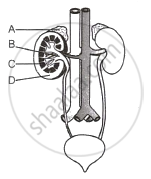Advertisements
Advertisements
Question
| Hormones | Target gland |
| Melanotrophin (MSH | ______ |
Solution
| Hormones | Target gland |
| Melanotrophin (MSH | Skin |
APPEARS IN
RELATED QUESTIONS
_______ maintains basic metabolic rate.
(A) Thyroxine
(B) ADH
(C) GH
(D) Oxytocin
In the table given below, fill in the blanks by naming endocrine glands, the hormones they secrete, and the function they perform, in a normal person.
| S.No. | Name of the gland | produced | Function |
| 1. | Thyroid | ||
| 2. | Insulin | ||
| 3. | Preparing the body for action | ||
| 4. | (i) Growth hormone (ii) Thyroid-stimulating hormone |
Mention any two differences between a hormone and an enzyme.
Name the hormone responsible for the following function:
Increased reabsorption of water in the kidneys
Choose the correct answer:
Corpus luteum produces ____________
Is the following gland an exocrine or an endocrine gland?
Liver
Organs like the stomach and intestine are also endocrine glands. Why?
Fill in the Blanks:
______ is called father of endocrinology.
Mention, if the following statement is True or False. If false rewrite the wrong statement in its correct form:
Hormones are produced by endocrine gland.
Given alongside are the diagrammatic sketches of some endocrine glands. Observe the figures and answer the following questions:

(i) Label the parts numbered 1 to 5.
(ii) Name the hormones secreted by (2) and (5).
(iii) Which chemicals in our body are greatly affected by hormones?
(iv) What is the chemical nature of hormones?
(v) Name the elements related to the functioning of hormones secreted by the structure (2) and (5).
State the Location
Prostate gland
Choose the Odd One Out
Choose the Odd One Out
Choose the Odd One Out
Choose the Odd One Out
Vasopressin is concerned with:
Hormones are known as chemical messenger. Justify.
In humans, the life processes are controlled and regulated by
Given below is the figure showing the human urinary system with structures labelled A to D. Select the option which correctly identifies them and gives their function.

Distinguish between Diabetes mellitus and Diabetes insipidus (endocrine gland concerned).
